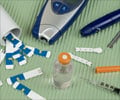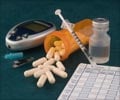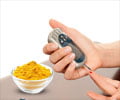Increased brightness of shoulder muscle on ultrasound imaging may be a warning sign of type 2 diabetes or prediabetes. However, early interventions can be initiated to avoid complications later.
- Incidental finding of bright appearing (hyperechoic) shoulder muscle on ultrasound imaging may be a warning sign of diabetes or prediabetes (condition of high blood sugar that can progress to frank diabetes over time)
- Over 7 million of the American population are not aware of their diabetic status and remain undiagnosed and at risk of developing complications associated with diabetes (involving heart, kidneys, eyes and nerves)
- Shoulder ultrasound may help identify persons who are having diabetes or prediabetes so that appropriate interventions can be initiated early to avoid complications later
"Every time we would ask one of these patients if they were diabetic, they would say 'yes' or they would tell us they were borderline and not taking any medications," Dr. Soliman said.
Read More..
Link between Bright Appearing Shoulder Muscle and Diabetes
The study was conducted to determine the association between bright appearing deltoid muscle and occurrence of diabetes or prediabetes.- Dr. Soliman and his team collected 137 shoulder ultrasound images from patients with type 2 diabetes, including 13 with pre-diabetes. They also obtained ultrasounds from 49 obese patients without diabetes
- The images were shown to two musculoskeletal radiologists who were not aware whether the images belonged to patients with diabetes or not
- Based on the brightness of the shoulder muscle, the radiologists were asked to classify the patients into one of three categories namely - normal, suspected diabetes and definite diabetes. A third musculoskeletal radiologist assumed the role of arbitrator in cases where the other two radiologists disagreed
- Using the shoulder ultrasounds, the radiologists correctly identified diabetes in 70 of 79 patients (89%). The results showed that a concurrence of "definite diabetes" by the radiologists was a strong indicator of diabetic status.
Here’s Why Brightness of Shoulder Muscle Increases in Diabetes and Prediabetes
The reasons for the brighter-appearing shoulder muscle on ultrasound in patients with diabetes is not fully clear, but scientists suspect that it could be related to decreased levels of glycogen in the muscle (a chemical that is a major source of energy for the body that is stored mainly in the liver and muscles for future use).A study of muscle biopsies showed that muscle glycogen levels are reduced by up to 65 percent in diabetes. Previous studies have found that the muscles of athletes appear brighter on ultrasound following a period of exercise when the muscle glycogen stores become depleted
"It could be that this appearance in people with diabetes and pre-diabetes is related to the known problems with glycogen synthesis in their muscles because of their insulin abnormalities," Dr. Soliman said.
Scope of Study - Initiation of Early Interventions
Finding of increased brightness of shoulder muscle may help in identifying persons who are unaware of their diabetic or prediabetic state by confirmatory blood tests.Initiating appropriate interventions early enough may overcome the need for taking medications by recommending lifestyle changes in some patients and avoid diabetes-associated complications.
Ultrasonologists at Henry Ford now put notes in their reports if the find bright appearing deltoid muscle indicating that this observation has been linked to diabetes.
Future Plans
The team plans to further study the association between shoulder muscle echogenicity and diabetes to see if there is a correlation between the intensity of brightness and degree of diabetes and determining if the finding can be reversed.Reference:
- Shoulder “Brightness” on Ultrasound May Be a Sign of Diabetes - (https://press.rsna.org/timssnet/media/pressreleases/14_pr_target.cfm?id=2038)
Source-Medindia
















